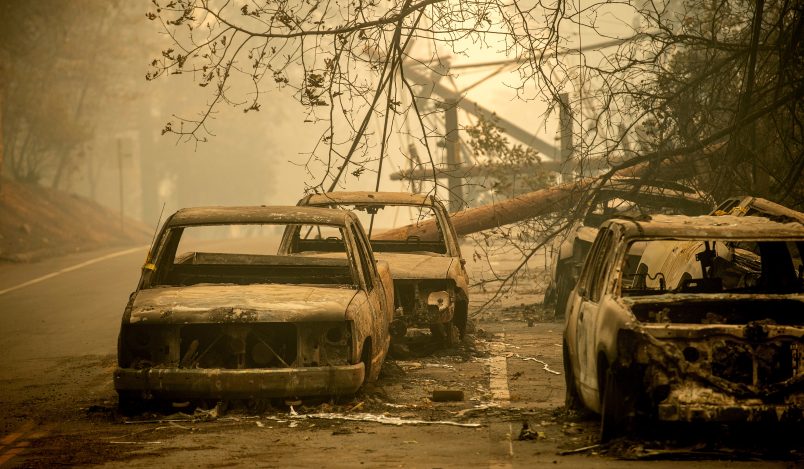PARADISE, Calif. (AP) — Authorities called in a mobile DNA lab and anthropologists to help identify the dead as the search went on for victims of the most destructive wildfire in California history. The overall death toll from the outbreak of fires at both ends of the state stood at 25 Sunday and appeared likely to rise.
All told, more than 8,000 firefighters battled three large wildfires burning across nearly 400 square miles (1,040 square kilometers) in Northern and Southern California, with out-of-state crews continuing to arrive and gusty, blowtorch winds forecast into Monday.
The worst of the blazes was in Northern California, where flames reduced the town of Paradise, population 27,000, to a smoking ruin days ago and continued to rage in surrounding communities. The number of people killed in that fire alone, at least 23, made it the third-deadliest on record in the state.
Butte County Sheriff Kory Honea said the county was bringing in more rescue workers and consulted anthropologists from California State University at Chico because in some cases “the only remains we are able to find are bones or bone fragments.”
“This weighs heavy on all of us,” Honea said.
Authorities were also bringing in a DNA lab and encouraged people with missing relatives to submit samples to aid in identifying the dead after the blaze destroyed more than 6,700 buildings, nearly all of them homes.
The sheriff’s department compiled a list of 110 people unaccounted for, but officials held out hope that many were safe but had no cellphones or some other way to contact loved ones.
Firefighters gained modest ground overnight against the blaze, which grew slightly to 170 square miles (440 square kilometers) from the day before but was 25 percent contained, up from 20 percent, according to state fire agency, Cal Fire.
But Cal Fire spokesman Bill Murphy warned that gusty winds predicted into Monday morning could spark “explosive fire behavior.”
Two people were also found dead in a wildfire in Southern California , where flames tore through Malibu mansions and homes in working-class Los Angeles suburbs. The severely burned bodies were discovered in a long residential driveway in Malibu, home to a multitude of Hollywood celebrities.
Among those forced out of their homes were Lady Gaga, Kim Kardashian West, Guillermo del Toro and Martin Sheen.
Flames also raged on both sides of Thousand Oaks, the Southern California city still in mourning over the massacre of 12 people in a shooting rampage at a country music bar Wednesday night.
Fire officials said Sunday morning that the larger of the region’s two fires, the one in and around Malibu, grew to 130 square miles (337 square kilometers) and was 10 percent contained. But firefighters braced for another round of Santa Ana winds, the powerful, dry gusts that blow out of the interior toward the coast.
The count of lost structures in both Southern California fires climbed to nearly 180, authorities said.
All told, a quarter-million people were under evacuation orders up and down the state.
Gov. Jerry Brown said he is requesting a major-disaster declaration from President Donald Trump that would make victims eligible for crisis counseling, housing and unemployment help, and legal aid.
Drought, warmer weather attributed to climate change and home construction deeper into forests have led to more destructive wildfire seasons in California that have been starting earlier and lasting longer.
California emerged from a five-year drought last year but has had a very dry 2018. Much of the northern two-thirds of the state is abnormally dry.
In Paradise, a town founded in the 1800s, residents who stayed behind to try to save their properties or who managed to return despite an evacuation order found incinerated cars and homes.
Wearing masks because the air was still heavy with smoke, people sidestepped metal that had melted off of cars or Jet-Skis as they surveyed their ravaged neighborhoods. Some cried when they saw nothing was left.
Jan McGregor, 81, got back to his small two-bedroom home in Paradise with the help of his firefighter grandson. He found his home leveled — a large metal safe and pipes from his septic system the only recognizable traces. The safe was punctured with bullet holes from guns inside that went off in the scorching heat.
He lived in Paradise for nearly 80 years, moving there in 1939, when the town had just 3,000 people and was nicknamed Poverty Ridge.
“We knew Paradise was a prime target for forest fire over the years,” he said. “We’ve had ’em come right up to the city limits — oh, yeah — but nothing like this.”
McGregor said he probably would not rebuild: “I have nothing here to go back to.”
___
This story has been corrected to fix survivor’s name to McGregor instead of MacGregor.
___
Associated Press writers Daisy Nguyen, Olga R. Rodriguez and Sudhin Thanawala in San Francisco contributed to this report. Darlene Superville contributed from Paris.



